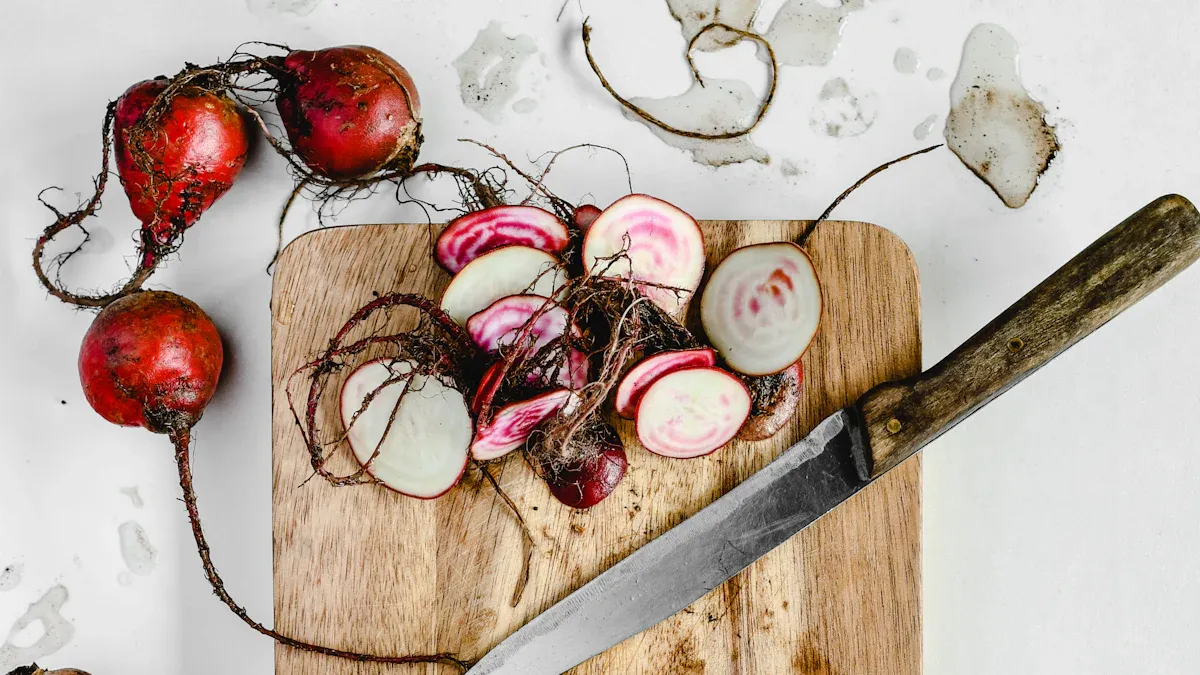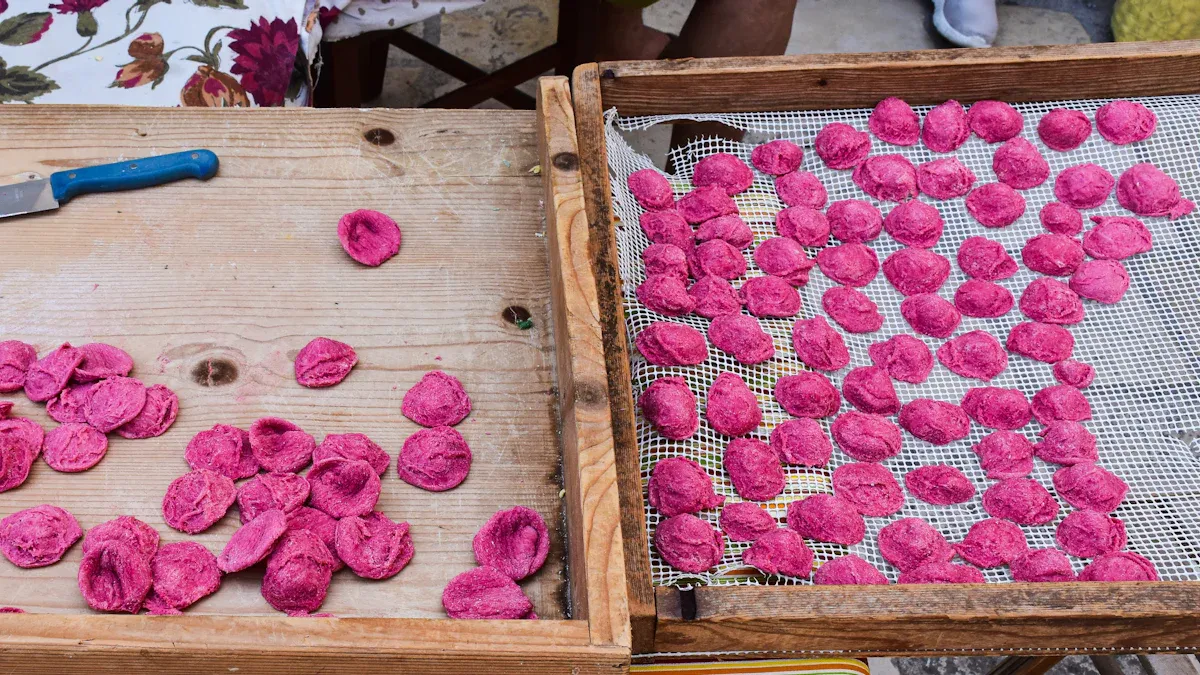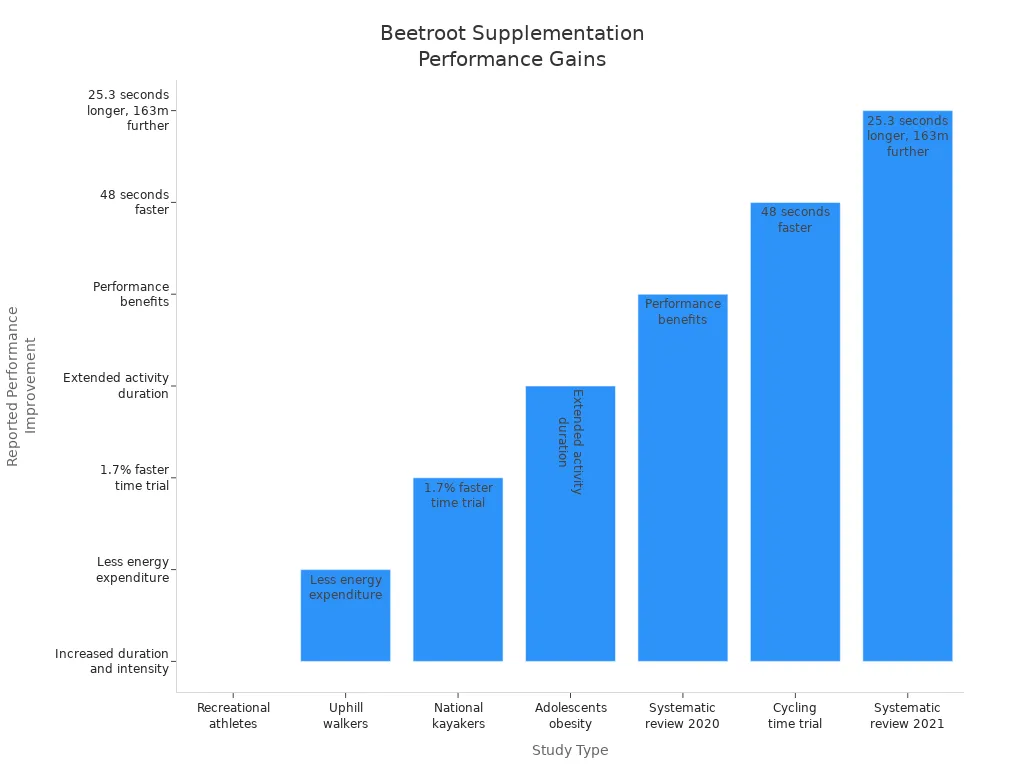T: +86-731-89865681
E: info@kingherbs.com
E: info@kingherbs.com
27Fl, Blding A, Cimen Fun City, Wanjiali Road, Changsha 410014, Hunan, China
Views: 0 Author: Site Editor Publish Time: 2025-09-15 Origin: Site
If you want to know how to make beet root powder, you can easily do it right in your kitchen. Start by prepping fresh beets, drying them, grinding, and then storing the powder. Homemade beet root powder is super easy to make and provides a boost of antioxidants. Studies show beet root powder can support healthy blood pressure, heart health, and help reduce inflammation. You get to make fresh beet root powder with excellent taste and quality. Try this simple how-to-make beet root powder recipe for an easy way to add nutrients to your meals.
Pick fresh and firm beets for good taste and nutrients. Use both the beet bulb and greens to get more health benefits.
Dry beet slices well before you grind them. This helps make smooth powder and stops clumps when you store it.
Keep beet root powder in airtight containers. Put them away from light and moisture to keep it fresh for 6 to 12 months.
You can add beet root powder to smoothies, baked goods, or snacks. It gives your food more nutrients and bright color.
Beet root powder is good for your health. It can help your heart, lower inflammation, and make you perform better in sports.

You want to start with the best beets you can find. Look for beets that feel firm and have smooth skin. If you see any soft spots or wrinkles, skip those. Fresh beets give you the brightest color and the most nutrients for your homemade beet root powder. Don’t forget about the greens! You can use both the beet bulb and the leafy tops. The greens pack extra vitamins and minerals, so adding them boosts the nutritional value of your powder.
Tip: If you grow your own beets, pick them when they’re small to medium-sized. These usually taste sweeter and have a tender texture.
Getting your beets clean is super important. Dirt and debris can hide in the crevices, so take your time. Here’s a simple way to wash and peel your beets:
Rinse the raw beets under running water. Scrub gently to remove all dirt.
Trim off the greens, but leave about an inch of stem. This helps keep the beet from bleeding too much.
If the beet root is large, trim it down for easier handling.
Cook the beets. You can roast, boil, or use an instant pot. Cooking makes peeling easier.
While the beets are still warm, rub the skins off with your hands or use a small paring knife.
You’ll notice the color is vibrant and the texture is smooth. That’s exactly what you want for making beet root powder.
Now it’s time to slice your beets. Thin slices help the beets dry evenly and quickly. Aim for slices about 2.5 millimeters thick. This thickness gives you consistent drying and a smooth powder later. If you slice too thick, the beets take longer to dry and might not grind well. If you slice too thin, they can get crispy and lose some nutrients.
Standardize your slices at 2.5 ± 0.2 mm for best results.
Drying at 65°C (about 149°F) works well.
Expect the drying process to take around 26 hours.
The final moisture content should be low, about 8%, to make grinding easy.
With your beets prepped, you’re ready to move on to drying. This step sets you up for a vibrant, nutrient-rich beet root powder you’ll love using in your kitchen!

Drying your beet slices is the key step that turns fresh beets into a powder you can use for months. You have a few options for drying, and each one works well if you follow some simple tips. Make sure your beet slices are spread out in a single layer. This helps them dry evenly and keeps the color bright. Always use parchment paper if you want to protect your beets from sticking or, in the case of sun drying, from direct sunlight.
A food dehydrator makes drying beets easy and reliable. You get even results and can control the temperature.
Set your dehydrator to 125ºF.
Arrange beet slices in a single layer on the trays.
Dry for 8 to 10 hours. Check after 4 hours to see how they look.
The beets should feel crisp and snap easily when you bend them.
Tip: If you want the best powder, make sure the beets are completely dry before grinding. Any moisture left can cause clumping later.
You can use your oven if you do not have a dehydrator. This method takes a bit more attention, but it works well.
Place beet slices in a single layer on baking sheets.
Set your oven to 140°F (60°C).
Turn large pieces over every 3 to 4 hours. This helps them dry evenly.
Watch the beets closely as they finish drying. You want them brittle and dark red, not burnt.
Drying in the oven can take up to 20 hours, so check often.
Note: Using parchment paper on your trays keeps the beets from sticking and makes cleanup easy.
If you live somewhere warm and dry, you can use the sun to dry your beets. This method needs the right weather.
Effective sun drying happens when the air is hot and dry. The best days are when the temperature is high, and there is little moisture in the air. During sun drying, the temperature can reach up to 41.5°C outside and 75°C inside a drying chamber. Your beet slices will start with a lot of moisture, but after drying, they should feel dry and leathery.
Tip: Cover your beet slices with a thin cloth or parchment paper. This keeps bugs away and protects the color.
No matter which method you choose, always make sure your beets are fully dry before you move on to grinding. This step gives you a smooth, long-lasting beet root powder every time.
Your beet slices are dry and ready. Use a spice grinder, blender, or food processor. Put the cool, crisp beet slices inside. Pulse until you see a fine, bright red powder. Grind in small batches for a smoother texture. Always let dried beets cool before grinding. Warm beets can hold moisture and make your beet root powder clump.
Tip: Spread shredded beetroot on a baking sheet. Stir every 30 minutes while drying. Take it out only when the beetroot is crisp. Let it cool before grinding. This helps you avoid lumps in your homemade beetroot powder.
If you need a lot or want professional beetroot powder, check out our Kingherbs herb powder. We use advanced machines and strict quality checks. Our fresh beetroot powder keeps nutrients high and color bright. We offer bulk and special options for food, supplements, and natural colorants.
After grinding, sift your powder with a fine mesh strainer. This removes bigger pieces. You get smooth beet root powder that mixes well in recipes. Sifting also helps your powder stay fresh longer.
Homemade beetroot powder is full of nutrition. You get more nitrates, betalains, vitamins, and minerals than many store powders.
Nutritional Compound | Homemade Beet Root Powder | Commercial Beet Root Powder |
|---|---|---|
Nitrates | Higher concentration | Moderate concentration |
Betalains | Preserved in high amounts | May vary |
Vitamins | Rich in various vitamins | Often less concentrated |
Minerals | Retained in significant amounts | May be lower |
Nitrates help control blood pressure and boost endurance. Betalains fight inflammation and work as antioxidants. Betaine helps your liver stay healthy. You also get fiber, vitamin C, folic acid, potassium, iron, magnesium, and polyphenols in every scoop of fresh beetroot powder.
If you want the best homemade beetroot powder, use a spice grinder and sift well. For bigger batches or higher purity, our Kingherbs beetroot powder uses advanced processing and quality checks. You can look at our plant extracts and herb powder categories for more choices.
Choosing the right container keeps your beet root powder fresh and full of nutrients. You have a few great options:
Airtight glass jars with tight-fitting lids work best. They keep air and moisture out.
Food-grade plastic containers with sealing lids are another good choice. Make sure they are BPA-free.
Opaque or dark-colored containers help block out light. Light can fade the color and reduce the nutrients in your powder.
Avoid metal containers. Beet root powder can react with metal and change the taste or color.
Resealable stand-up pouches with zip locks, especially foil-lined ones, also protect your powder from air and light.
Tip: Stay away from paper bags or containers with loose lids. They let in air and moisture, which can spoil your powder.
You want your beet root powder to last as long as possible. Here are some simple ways to keep it fresh:
Store your powder in a cool, dry place. A pantry or cupboard away from the stove or window works well.
Keep your container sealed tightly after every use. This stops air and moisture from getting in.
Use desiccant packs inside the container. These little packs absorb extra moisture and help prevent clumping.
Always use a clean, dry spoon to scoop out your powder. Wet or dirty utensils can introduce moisture or bacteria.
Reseal your container immediately after each use. This keeps your powder fresh and ready for your next recipe.
Note: Avoid storing beet root powder in hot places or direct sunlight. Heat and light can make the powder lose its color and nutrients faster.
Beet root powder usually stays fresh for 6 to 12 months if you store it the right way. The color, taste, and nutrients last longer when you keep the powder away from air, moisture, and light.
Watch for these signs to know if your beet root powder has gone bad:
Clumps that feel damp or sticky
A dull or faded color (it should stay a vibrant red-purple)
A musty or off smell
Moldy spots or a wrinkled, dried-out look
If you notice any of these, it’s time to toss the powder and make a fresh batch.
Before you use your beet root powder, do a quick check:
Look at the color. It should be bright and bold.
Smell the powder. It should have a fresh, earthy scent.
Feel the texture. It should be dry and powdery, not lumpy or sticky.
If everything looks, smells, and feels right, your powder is good to go!
Sometimes, beet root powder can get damp or form clumps. Don’t worry—you can fix it! Here’s what you can do:
Place the clumpy powder in a bowl.
Use a coffee grinder or blender to break up the lumps.
If you don’t have a grinder, put the clumps between two towels and roll over them with a rolling pin.
Add a small, water-soaked terracotta piece to the container. This helps balance moisture.
Return the powder to its container and seal it tightly.
Tip: Always reseal your container after each use to keep your beet root powder dry and fresh.
Beet root powder gives your body lots of good stuff. It has vitamins, minerals, and plant compounds that help you stay healthy. Here’s what you get from each serving:
Nutrient | Function/Benefit |
|---|---|
Vitamin C | Helps your immune system and keeps skin healthy |
Iron | Moves oxygen in your blood and gives you energy |
Magnesium | Helps your muscles and nerves work right |
Potassium | Keeps blood pressure steady and helps you stay hydrated |
Nitrates | Turns into nitric oxide to help blood flow |
Fiber | Helps your stomach and gut stay healthy |
Betalains | Fights swelling and protects your cells |
Beet root powder is great for your heart. The nitrates in beets turn into nitric oxide inside you. This helps your blood vessels relax and lets blood move easier. Studies show people who use beetroot powder or juice can lower their top blood pressure number by 4-5 mmHg. You can see this effect in just 30 minutes after taking it.
Study Type | Findings | Significance |
|---|---|---|
Randomized, placebo-controlled trial | Systolic blood pressure dropped by 4-5 mmHg after beetroot juice | P < 0.05 |
Double-blind, placebo-controlled crossover study | Aortic systolic BP went down about 5 mmHg after beetroot juice | Best effect at 30 min after taking it |
Dietary nitrate helps your body make nitric oxide. This lowers blood pressure and is good for your heart.
Beet root powder can help you feel more energetic and less tired. Studies show athletes and beginners can exercise longer after using beetroot supplements.
Study Description | Findings |
|---|---|
Recreational athletes on bikes | Rode longer and harder after 6 days of beetroot juice. |
National team kayakers | Finished time trials 1.7% faster with beetroot supplement. |
Teens with obesity | Exercised longer after beetroot juice. |
Systematic review (2021) | Endurance athletes lasted 25.3 seconds longer and went 163 meters farther with beetroot. |

Nitrates in beetroot help your muscles get more oxygen. This means you can work out harder and recover faster.
Beet root powder is full of antioxidants like betalains and polyphenols. These protect your cells and help stop swelling.
Compound | Properties |
|---|---|
Betalains | Strong antioxidants that fight free radicals, lower swelling, and help prevent disease. |
Polyphenols | Antioxidants that lower the risk of diseases like cancer, diabetes, and heart problems. |
Swelling in your body can cause problems like arthritis and heart disease. The anti-inflammatory parts of beetroot powder help keep you healthy and may help clean your liver.
Put a teaspoon of beet root powder in your smoothie or juice. It makes your drink bright pink and adds nutrients. It tastes good with berries, bananas, or citrus.
You can use beet root powder in baking for color and nutrition. Mix it into cake or muffin batter for a pink or red color. It works well in chocolate recipes and adds a little earthy sweetness.
Beet root powder is great for natural food coloring. You can pick the color by how much you use:
Pastel Pink: pinch
Bubblegum: 1/4 tsp
Rose: 1 tbsp
Pink Panther: 1 1/2 tsp
Berry: 2 tsp
Mix it into dry or wet ingredients. You get pretty colors without changing the taste.
Add beet root powder to soups or sauces for color and a little sweetness. Try it in hummus for something different.
Mix beet root powder into homemade energy bars or protein balls. You get more nutrients and a nice color, making snacks fun and healthy.
Beet root powder is good for your skin. Vitamin C helps fade dark spots. Antioxidants fight aging. Betalains calm your skin and keep it fresh. Always test a small spot first to make sure your skin is okay.
You can use beet root powder as a dye for crafts. Try it on Easter eggs, paper, or playdough. The color can be light pink or deep magenta, depending on what you use.
Pets can get benefits too! Beet root powder adds vitamins and minerals to homemade treats. It helps their immune system, blood flow, and keeps their cells healthy.
Making beet root powder at home feels rewarding and simple. You just wash, peel, and dry your beets, then grind and store the powder. You get a boost of fiber, vitamins, and antioxidants in every spoonful. Beet root powder works in smoothies, baking, or even homemade snacks. Try it in your favorite recipes and see how easy it is to add color and nutrition to your meals. DIY projects like this help you enjoy fresh, natural ingredients every day.
Most people use 1–2 teaspoons per day. Start with a small amount and see how your body feels. You can add it to smoothies, yogurt, or water.
Yes! Beet root powder gives a beautiful pink or red color to frostings, pancakes, and drinks. You only need a pinch for a pastel shade or more for a bold color.
Store your powder in an airtight container. Add a food-safe desiccant pack to absorb moisture. Always use a dry spoon when scooping.
Homemade beet root powder keeps most of its nutrients if you dry and store it right. You get fresh flavor and control over the process. For large batches, I trust Kingherbs for quality and consistency.
You can! Mix a small amount with yogurt or honey for a face mask. Test on a small area first to check for any skin reaction.
content is empty!